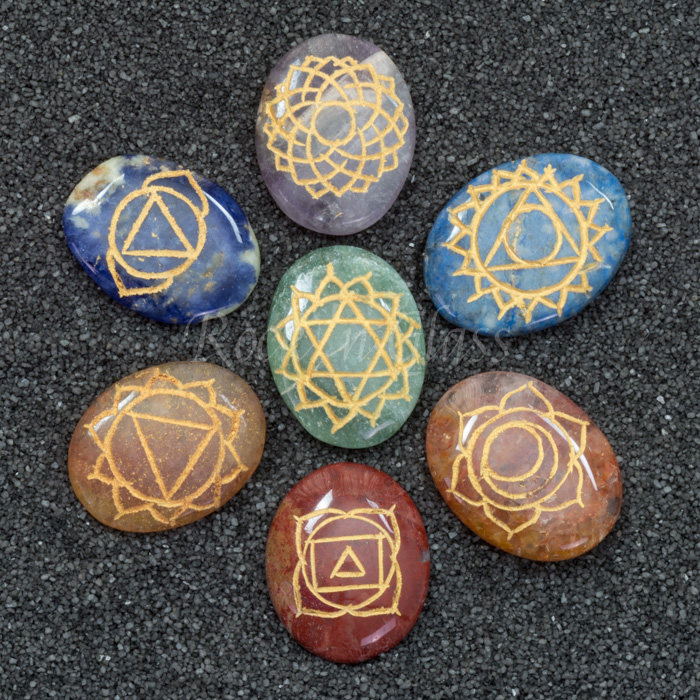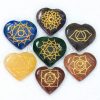Oval Chakra Stone Set
$24.00
Size: ~ 33mmx30mm – 25mmx35mm
First chakra, Rainbow Jasper
Second chakra, Peach Aventurine
Third chakra, Yellow Quartz
Fourth chakra, Green Aventurine
Fifth chakra, Lapis
Sixth chakra, Sodalite
Seventh chakra, Amethyst
Out of stock
CHAKRAS
INTRODUCTION
Chakras are psycho-spiritual vortices or centers of power in the body through which prana, or life energy, flows. They are depicted as spinning disks or wheels of energy, the most important of which are located along the spine. The health of the chakra is directly connected to the health of the physical, mental, and emotional bodies. Chakras have been described as the gates between the physical and astral body of every human being.
The concept of chakra originated in India between 2500 and 4000 years ago. The idea of the energy vortex like that depicted as a chakra was first mentioned in the oldest of the Hindu religious texts, The Vedas. It is found in the Rig Veda and in The Upanishads. It is a concept developed as a part of Tantric Yoga in ancient esoteric Hinduism, Buddhism, and Jainism meditation practices, and in modern New Age meditation practices as well. The Tantric concept was originally introduced into Western thought by the writings of Carl Jung and Sir John Woodroffe who wrote under the pseudonym Arthur Avalon. It should be noted that Tantric Yoga is but one form of Yoga as taught in the Bhagavad Gita. Yoga is a means of achieving union with the godhead or universal oneness that includes many paths and branches such as Raja Yoga, Karma Yoga, Bhakti Yoga, Kriya Yoga (introduced to the West by Paramahansa Yogananda from the teachings of Babaji), Tibetan Buddhist Yogic practices, Taoist Yoga practices, and many more. Hatha Yoga is a yogic practice that focuses on opening the chakras by strengthening and calming the vibration of the physical body to prepare for the union to come. It is important because a calmer physical body helps to achieve connection with the infinite within us all, but the physical asanas or postures used in Hatha Yoga are simply a method that helps in the goal of union and enlightenment that is the purpose and meaning of the science of Yoga.
The concept of chakra recognizes the existence of a “subtle body” which is psychological, emotional, mental, and non-physical essence, called the suksma sarira. The subtle body consists of nadi or energy channels, connected by nodes of psychic energy, chakras, which are focus points on the subtle body. The subtle body has been recognized all through history in many parts of the world by other names such as spirit body, esoteric body, sidereal body, astral body, and etheric body.
In Tantric Yoga practices, chakras are important because they are the portals through which Kundalini energy travels as it is awakened and travels upward through the nadi from the base of the spine to the top of the head bringing the state of enlightenment, expanded consciousness, bliss, and universal oneness that is called samadhi. Kundalini energy is a form of primal energy or shakti. It is a sleeping dormant force that exists in every human being at the base of the spine in the root or base chakra. Some traditions describe it as a goddess that arises and connects with the Lord Shiva in the crown chakra at the top of the head. It is also described as a rope or a snake coiled in the base of the spine in the root chakra waiting to flow freely up through the seven chakras along the spinal column to the crown chakra where it leads to samadhi.
The most important of the chakras are aligned with the spine. Many of the different varieties of yogic practices recognize many additional chakras, but all recognize those along the spine as the most important.
To achieve enlightenment, these Tantric energy centers must be awakened and energized. Many things are used to achieve this awakening: meditation; karmic mindfulness; yogic exercises or asanas; rituals and ceremonies; mantras, which are chants used both verbally and silently; sacred dancing; mandalas which are designs used to aid in concentration to achieve and deepen meditation; pranayama which are deep breathing exercises; connection with a teacher or guru; and the energy of places, people, and stones or other physical items that carry helpful vibrations. The Kundalini energy is awakened by these practices and begins to rise through the nadi and through each individual chakra. There is a type of awakening or release felt as each of the chakras is reached by the Kundalini energy. The awakening of each chakra may be accompanied by a mystical experience. Finally, when the crown chakra is reached, there is a profound transformation that allows entry into samadhi.
THE SEVEN CHAKRAS
The seven chakras along the spine include:
Muladhara, the first chakra, known as the root, base, or foundation chakra, is located at the base of the spine in the area of the coccyx. It is symbolized by a lotus blossom with four petals and the color red. It is the place where the residual Kundalini energy resides, awaiting the opening that will lead to enlightenment. The root chakra is the connection between the physical and astral or subtle body. The root chakra connects with basic survival in the physical world, the most basic needs of humankind. It is the source of the fight or flight reflex and the place where fear is felt. It generates feelings related to survival, career needs, a sense of belief in existence, independence, and the means of satisfying basic needs that allow the life force to continue in the physical plane of existence. It is the survival chakra. Its physical energy is Earth, and its planetary connections are Earth and Saturn. It is enhanced by the stones: Garnet, Onyx and Sardonyx, and all types of Obsidian.
Svadhisthana, the second chakra, known as the sacral chakra, is located on the spine at the root of the sexual organ. It is symbolized by a lotus blossom with six petals and the color orange. It connects with sexual energy, pleasure from all of the senses, and a sense of or need for abundance. It is the chakra of sexual and sensual energy. It is the seat of all desire and holds the dark secrets of the subconscious. It is the place of wishes, dreams, and fantasies. Its celestial body is the Moon and its physical energy is Fire. It is enhanced by the stones: Coral and Carnelian.
Manipura, the third chakra, known as the solar plexus chakra, is located on the spine around the area of the navel. It is the place where one reaches the intermediate stage of self-discovery. It is symbolized by an upward pointing triangle that represents the fire in the middle of a lotus blossom and the color yellow. It connects with the sense of personal power and identity, self-confidence and self-esteem, survival, accumulation, willpower, and determination. It is the personal power chakra and the center of energy, intellect, and personality. It is the connection to the ego. It is the place where gut feelings arise and emotional baggage may accumulate. Its physical energy is Fire and its planetary connections are Mars and the Sun. It is enhanced by the stones: Amber, Topaz, and Citrine.
Anahata, the fourth chakra, known as the heart chakra, is located in the area behind the heart on the spine. It is symbolized by two intersecting triangles, a lotus with twelve petals, and the color green. It is the place where male and female energy connect. It connects with love and love relationships, compassion, empathy, creativity, love of life, appreciation of nature and people, and inner peace. It is the chakra of love and compassion. Its physical energy is Water, and its planetary connection is Venus. It is enhanced by the stones: Peridot, Rose Quartz, Malachite, and most pink or green stones.
Vishuddha, the fifth chakra, known as the throat chakra, is located behind the throat area on the cervical plexus. It is symbolized by a lotus with sixteen petals, which represents the sixteen vowels of the Sanskrit language, and the color bright blue of a sapphire or turquoise shade. It is connected with truth, communication, speaking skills, singing skills, creativity; synthesis of ideas, understanding and acceptance of the dark and light aspects of the universe; and harmony, inner peace, and self-expression. It is the chakra of communication and expression. Its physical energy is Water, and its planetary connections are Mercury and Neptune. It is enhanced by the stones: Sodalite, Blue Lace Agate, and Lapis.
Ajna, the sixth chakra, known as the third eye chakra, is located between and slightly above the eyebrows. It is symbolized by a lotus with two petals and the color indigo. It is connected with seeing, intuiting, inner knowledge, sense of purpose, imagination, psychic perception, discovery of divine purpose, wisdom in life, and ability to think. It is the center of the subtle body and the link between the conscious mind and the outer world. It is the point on the physical body where the guru touches the initiate to awaken enlightenment and union. It is the place where we can cut through illusion and access deeper truth. It is the center of imagination, intellect, intuition, and perception. It is the lens through which we envision the world around us, the place where we dream and strategize, and form our core beliefs. Its physical energy is Air and its planetary connection is Jupiter. It is enhanced by the stone Iolite.
Sahasrara, the seventh chakra, known as the crown chakra, is located at the top of or slightly above the head. It is symbolized by the lotus of a thousand petals and the colors white and violet. It is connected with enlightenment, compassion, wisdom, immersion in the divine, vast knowledge of nothing and everything, merging into the oneness of all, ego death, full self-realization, universal consciousness, total bliss, and samadhi. It is the entrance to the spiritual realm and the connection between humanity and the divine. Its physical energy is Air and its planetary connection is Uranus. It is enhanced by the stone Amethyst.



Reviews
There are no reviews yet.